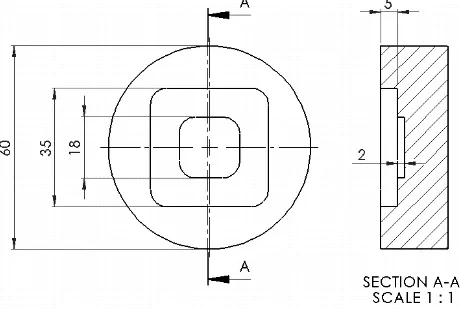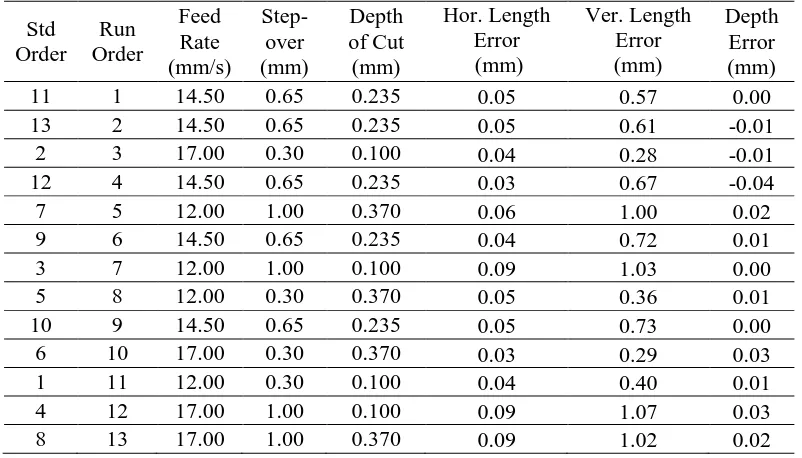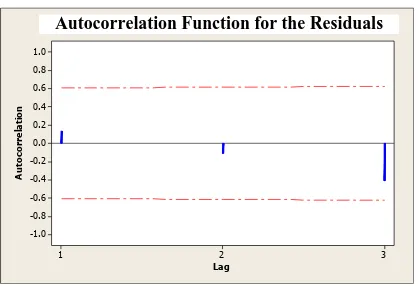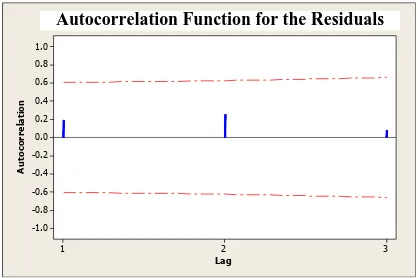This content has been downloaded from IOPscience. Please scroll down to see the full text.
Download details:
IP Address: 203.114.224.228
This content was downloaded on 29/03/2017 at 01:07
Please note that terms and conditions apply.
The Influence of Depth of Cut, Feed Rate, and Step-over on Dimensional Accuracy in
Subtractive Rapid Prototyping of Polycarbonate Material
View the table of contents for this issue, or go to the journal homepage for more 2017 IOP Conf. Ser.: Mater. Sci. Eng. 187 012033
(http://iopscience.iop.org/1757-899X/187/1/012033)
Home Search Collections Journals About Contact us My IOPscience
You may also be interested in:
Study on surface finish of AISI 2080 steel based on the Taguchi method S Yalcinkaya and Y ahin
Effect of copper addition at a rate of 4% weight on the machininability of ZA-21A1 cast alloy by CNC milling
S M A Alqawabah and A I O Zaid
Prototyping of Dental Structures Using Laser Milling A O Andreev, M S Kosenko, V N Petrovskiy et al.
Fuzzy Logic Modeling For Peripheral End Milling Process S Z Razali, S V Wong and N Ismail
A Study of the dimensional accuracy obtained by low cost 3D printing for possible application in medicine
K Kitsakis, P Alabey, J Kechagias et al.
Design of an instrumented smart cutting tool and its implementation and application perspectives Chao Wang, Kai Cheng, Xun Chen et al.
Effect of residual stress and surface roughness on the fatigue behaviour of aluminium matrix composites
M Smaga and D Eifler
Studies on Effect of Fused Deposition Modelling Process Parameters on Ultimate Tensile Strength and Dimensional Accuracy of Nylon
The Influence of Depth of Cut, Feed Rate, and Step-over on
Dimensional Accuracy in Subtractive Rapid Prototyping of
Polycarbonate Material
T J Suteja
Department of Manufacturing Engineering, University of Surabaya, Raya Kalirungkut, Surabaya, Indonesia
jayasuteja@staff.ubaya.ac.id
Abstract. Subtractive rapid prototyping is fast and automatic three dimensions physical modelling that uses computer aided design model as the input. The dimensional accuracy of the result of the subtractive rapid prototyping is influenced by its process parameters. The aim of this research is to study and then develop a model that shows the influence of depth of cut, feed rate, and step-over on the vertical length error, horizontal length error, and depth error in subtractive rapid prototyping of polycarbonate material. This research implements response surface methodology to develop the model and then followed by the residual tests to evaluate the developed model. The result shows that the increase of the feed rate and the step-over will increase the horizontal dimension error. The most influenced factor on the horizontal dimension error is the step-over. Meanwhile, the vertical dimension error will be affected mostly by the step-over. Last, the depth error is influenced by the feed rate, the step-over, and the depth of cut. The depth of cut is the most critical factor that increases the depth error. The developed models give an insight on how several process parameters of rapid prototyping will influence the dimensional accuracy of a polycarbonate material. Based on the model, efficient resources utilization can be achieved.
1.Introduction
Polycarbonate material is a strong, tough, and transparent thermoplastic material that is used in various applications including in tooling. As an example, a polycarbonate can be implemented as a complex shape chocolate mould. In order to produce a complex shape mould, a subtractive rapid prototyping is implemented as it is typically suitable for polycarbonate material to produce parts that require specific finishes.
Subtractive rapid prototyping is fast and automatic three dimensions physical modelling that uses Computer Aided Design model as the input. The physical modelling process is performed by implementing milling process to cut the raw material with tool that rotates in very high speed. According to Toh, C.K., the milling process with 10 mm tool diameter that is rotated in 10.000 rpm is called high speed milling [1]. Therefore, the subtractive rapid prototyping can be categorised as a high speed milling.
One of the important considerations in manufacturing a mold by using subtractive rapid prototyping is the dimensional accuracy of the mold. However, no research found in the literature that investigates the influence of high speed milling process parameters on the dimensional accuracy of the polycarbonate material. Most of the previous studies found in the literature investigate the dimensional ICMAE IOP Publishing
accuracy of part produced by additive rapid prototyping [2-6]. According to Ippolito, R., et. al., one of the additive rapid prototyping processes which is Stereolithography process can achieve the average dimensional accuracy until 0,08 mm [3]. This research also describes that the highest dimensional accuracy for additive rapid prototyping process is achieved by using Fused Deposition Modelling. The achieved dimensional accuracy of this process is 0,03 mm. However, this process will generate higher surface roughness compared to other processes.
Nieminem, I., et. al., investigate the possibility to use high speed milling to fabricate a thin fin of polycarbonate material by changing the depth of cut and step-over [7]. However, Nieminem, I., et. al. did not investigate the influence of these parameters on the dimensional accuracy of the polycarbonate material.
Based on the studies conducted by Oktem, H., et al., The, J.S., et. al., the dimensional accuracy of a milling process are affected by interpolation type, tool holder type, controller of the machine, computer aided manufacturing software, physical and mechanical characteristics of the material, physical and mechanical characteristics of the tool, vibration, depth of cut, step-over, feed rate, cutting speed, and cut type. [8-12].
The aim of this research is to study and develop a model that shows the influence of depth of cut, feed rate, and step-over on the dimensional accuracy of polycarbonate material in subtractive rapid prototyping. These three process parameters are selected because these parameters are the dominant factors that influence the material rate removal and the dimensional accuracy simultaneously.
2.Research methodology
This research implements Response Surface Methodology to develop the dimensional accuracy model. To validate the developed model, three residual tests, which are independence test, constant variance test, and normality test are conducted.
In this research, the subtractive rapid prototyping process is implemented on the polycarbonate material to achieve the shape shown in figure 1. The subtractive rapid prototyping machine used in this research is Roland MDX 40. The machine is assisted by CAM Modela Player 4.0 software to generate the tool path. The required input to generate the tool path is a three dimension model in STL format. The software uses zigzag cut type to move the cutting tool. The cutting tool used in this research is carbide solid square end mill with 5 mm diameter.
Figure 1. The designed shape.
Roughing and finishing processes are applied in order to create the shape above. Each process requires different parameter values. Table 1 shows the parameter value of the subtractive rapid prototyping for the roughing process. For finishing process, three levels of value for depth of cut, feed rate, and step-over are determined. The value of each level for each parameter is determined based on the machine specification, literature study, and the preliminary experiment as shown in table 2. Meanwhile, the spindle and the entry speed for finishing process are 10000 rpm and 4 mm/s consecutively. In this research, no coolant is used in performing the subtractive rapid prototyping.
ICMAE IOP Publishing
IOP Conf. Series: Materials Science and Engineering 187(2017) 012033 doi:10.1088/1757-899X/187/1/012033
Table 1. Parameter value for roughing.
Feed Rate : 12 mm/s
Entry Speed : 4 mm/s
Spindle Speed : 8500 rpm
Depth of Cut : 0.37 mm
Step-over : 1 mm
Table 2. Parameter value for finishing.
Low Middle High
Depth of Cut (mm) 0.1 0.235 0.37
Feed Rate (mm/s) 12 14.5 17
Step-over (mm) 0.3 0.65 1
This research takes several assumptions, which are the polycarbonate material is always homogeneous, the cutting temperature is always constant, and the tool wear occurs after performing three roughing and finishing processes.
The response investigate in this research is the dimensional accuracy. The measurement of the dimensional accuracy is conducted at Industrial Metrology Laboratory of University of Surabaya. The dimensional accuracy is determined based on the difference between the actual and the designed length of horizontal edge (paralel to the feed direction), the difference between the actual and the designed length of vertical edge (paralel to the step over direction), and the difference between the actual and the designed depth of the hole. The actual lenght and the depth are measured by using a caliper with 0.01 µm of accuracy. After the measurement process, the measured data is analyzed by using MINITAB release 14 software.
3.Result and discussion
The first step in implementing the response surface methodology is designing and conducting the first order experiment. The experimental design and the result of the first order experiment are shown in table 3. Based on the experiment results, the first order models of horizontal length error, vertical length error, and depth error are developed.
Table 3. Experiment results.
Std Order
Run Order
Feed Rate (mm/s)
Step-over (mm)
Depth of Cut
(mm)
Hor. Length Error (mm)
Ver. Length Error (mm)
Depth Error (mm)
11 1 14.50 0.65 0.235 0.05 0.57 0.00
13 2 14.50 0.65 0.235 0.05 0.61 -0.01
2 3 17.00 0.30 0.100 0.04 0.28 -0.01
12 4 14.50 0.65 0.235 0.03 0.67 -0.04
7 5 12.00 1.00 0.370 0.06 1.00 0.02
9 6 14.50 0.65 0.235 0.04 0.72 0.01
3 7 12.00 1.00 0.100 0.09 1.03 0.00
5 8 12.00 0.30 0.370 0.05 0.36 0.01
10 9 14.50 0.65 0.235 0.05 0.73 0.00
6 10 17.00 0.30 0.370 0.03 0.29 0.03
1 11 12.00 0.30 0.100 0.04 0.40 0.01
4 12 17.00 1.00 0.100 0.09 1.07 0.03
8 13 17.00 1.00 0.370 0.09 1.02 0.02
ICMAE IOP Publishing
The mathematical model to predict the horizontal length error values is shown in equation (1). Figure 2 and 3 shows that the residual of the horizontal length error model is to be normally and independently distributed. Furthermore, based on the regresion equation analysis, the residual of the horizontal length error model is identical. The residual tests show that the first order model of horizontal length error is satisfy all the assumptions and can be used as the best prediction of horizontal length error model and no second order experiment is required to be conducted. This model shows that the increase of the feed rate and the step over will increase the horizontal length error value. In the opposite, the increase of the depth of cut will decrease the horizontal length error value. According to the model, the horizontal length error is mostly affected by the step-over.
Ehor = 0.0144289 + 0.0005 x F + 0.0607143 x S – 0.0277778 (1)
where:
Ehor is horizontal length error (mm) F is feed rate (mm/s)
Uji Distribusi Normal Error Panjang Sisi Horisontal
Normal
Figure 3. Autocorrelation plot of the residuals for horizontal length error.
Furthermore, the mathematical model to predict the vertical length error values is shown in equation (2). Figure 4 and 5 shows that the residual of the vertical length error model is to be normally and independently distributed. Furthermore, the residual of the vertical length error model is identical based on the regresion equation analysis.
Ever = 0.143584 – 0.0065 x F + 0.996429 x S – 0.1018528 x D (2)
where:
Ever is vertical length error (mm) F is feed rate (mm/s)
S is step-over (mm) D is depth of cut (mm).
This model shows that the increase of the step-over will increase the vertical lenght error value. Meanwhile, the increase of the depth of cut will decrease the vertical length error value. Based on the residual tests, the first order model of vertical lenght error is satisfy all the assumptions and can be used as the best prediction model for vertical length error.
Last, the mathematical model to predict the depth error is developed as shown in equation (3).
Edepth = - 0.0342093 + 0.0015 x F + 0.0107143 x S + 0.0462963 (3)
IOP Conf. Series: Materials Science and Engineering 187(2017) 012033 doi:10.1088/1757-899X/187/1/012033
D is depth of cut (mm).
Uji Distribusi Normal Error Panjang Sisi Vertikal
Normal
Figure 5. Autocorrelation plot of the residuals for vertical length error.
Figure 6 and 7 shows that the residual of the depth error model is to be normally and independently distributed. Furthermore, based on the regresion equation analysis, the residual of the depth error model is identical. The mathematical model shows that the depth error will increase following the increase of the feed rate, the step over, and the depth of cut. The model also shows that the most influenced factor is the depth of cut. The residual tests shows that the first order model of depth error is satisfy all the assumptions and can be used as the best prediction model for depth error.
err depth
Figure 7. Autocorrelation plot of the residuals for depth error.
4.Conclusions
This result of this research shows that the increase of the step-over will increase the vertical and horizontal length errors. In addition, the increase of the feed rate will increase the vertical length error. Meanwhile, the increase of the depth of cut will decrease the vertical and horizontal length error value. Additionally, the depth error will increase following the increase of all process parameters. This most affected factor of the length error and the depth error are the step-over and the depth of cut consecutively.
The developed error models give an insight on how several process parameters of rapid prototyping will influence the dimensional accuracy of a polycarbonate material. Based on the model, efficient resources utilization can be achieved. This research also provides a preliminary study to optimize the material removal rate and the accuracy in rapid prototyping of the polycarbonate material. For the future work, the optimization of various parameters in rapid prototyping of the polycarbonate material to achieve the highest accuracy, the highest material removal rate, and the minimum surface roughness
Autocorrelation Function for the Residuals
Autocorrelation Function for the Residuals
ICMAE IOP Publishing
need to be done. In addition, based on the experiment results, there is a possibility that the length error is affected by the length of the designed shape. In the future, it is also important to investigate this possibility further.
5. References
[1] Toh C K 2004 Surface topography analysis in high speed finish milling inclined hardened steel Precision Engineering 28(4) 386-398
[2] Islam M N, Boswell B and Pramanik 2013 A An investigation of dimensional accuracy of parts produced by three-dimensional printing Proc. the World Congress on Engineering vol 1
[3] Ippolito R, Iuliano L and Gatto 1995 A benchmarking of rapid prototyping techniques in terms of dimensional accuracy and surface finish CIRP Annals-Manufacturing Technology 44(1) 157-160
[4] Taft R M, Kondor S and Grant G T 2011 Accuracy of rapid prototype models for head and neck reconstruction The Journal of prosthetic dentistry 106(6) 399-408
[5] Pal D K and and Ravi B 2007 Rapid tooling route selection and evaluation for sand and investment casting Virtual and Physical Prototyping Journal 2(4) 197-207
[6] Brajlih T, Valentan B, Balic J and Drstvensek I 2011 Speed and accuracy evaluation of additive manufacturing machines Rapid prototyping journal 17(1) 64-75
[7] Nieminen I, Paro J and Kauppinen V 1996 High-speed milling of advanced materials Journal of Materials Processing Technology 56(1-4) 24-36
[8] Oktem H, Erzurumlu T and Kurtaran H 2005 Application of response surface methodology in the optimization of cutting conditions for surface roughness Journal of Materials Processing Technology 170(1-2) 11-16
[9] The J S and Candra S 2008 Optimasi proses pemesinan milling fitur pocket material baja karbon rendah menggunakan response surface methodology Jurnal Ilmiah Teknik Mesin Universitas Kristen Petra 10(1) 1-7
[10] Ma W, He G, Zhu L and Guo L 2016 Tool deflection error compensation in five-axis ball-end milling of sculptured surface The International Journal of Advanced Manufacturing Technology 84(5-8) 1421-1430
[11] Zeroudi N and Fontaine M 2015 Prediction of tool deflection and tool path compensation in ball-end milling Journal of Intelligent Manufacturing 26(3) 425-445
[12] Shimana K, Kondo E, Karashima H, Nakao M and Yamashita S 2016 An approach to real-time compensation of machining error using deflection of tool estimated from cutting forces in end-milling process Journal of Advanced Mechanical Design, Systems, and Manufacturing 10(2) 1-10
ICMAE IOP Publishing
IOP Conf. Series: Materials Science and Engineering 187(2017) 012033 doi:10.1088/1757-899X/187/1/012033



